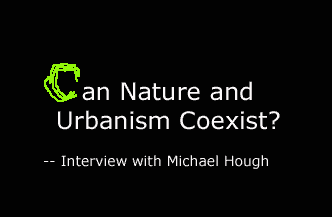 |
Principal and Founding
Partner of
Hough Woodland Naylor Dance Leinster
Professor, Faculty of Environmental Studies,
York University, Toronto, Canada.
Prof.
Michael Hough was one of the keynote speakers for the 38th International
Federation of Landscape Architect (IFLA) World Congress held from 26 June
2001 in Singapore. His paper Linking Sustainability with Urbanism and
Natural Process is a discussion on how nature and urbanism can, and must,
coexist as part of urban culture at both local and regional scale. In
this interview, he talked further about this views and his personal experience
in assisting the process of sustainability.
Q:
How did you arrive at your present focus in ecological planning and design?
A: It evolved over quite a long period of
time. I studied under Professor Ian McHarg at the University of Pennsylvania,
who was well known as an ecological planner. His book "Design with
Nature" was very influential, both to me and to the professional
schools of planning and designs in North America. His fundamental message
was that the natural processes that sustain life on earth must become
the central determinants that sharp all human activities on the land.
After leaving university, I began to realize that his work inspiring though
it was, largely ignored the physical environment of the city. So I decided
that I should take on the task of bringing nature and cities together
in urban design and landscape architecture. Hence my book City Form and
Natural Process came out in 1984. The second book Cities and Natural Process,
1995, was an outgrowth of the first, and the one in circulation now.
Q:
What is your main thesis in Cities and Natural Process?
A: There are two main premises on which the
book is based. First, that an environmental view of the city is an essential
component of the economic, engineering, political, and urban design processes
that have traditionally shaped the physical and environment of the cities.
The often unrecognised natural processes occurring within cities provide
us with an alternative basis for their form and evolution. Second, that
the solutions to the many problems facing cities and their growth require
that we take the concept of sustainability seriously. Sustainability is
in essence an environmental view. It means that we have to live within
the limits of the natural forces that support human and non-human life.
In
the 1970's many of us in North America and Europe got caught up in an
early version of sustainability that was called self-sufficiency. This
was something one did in the rural areas - not the city. It meant living
off the land, generating one's own power, growing one's own food, and
recycling everything. As a city person, I was interested in this movement
and started asking questions about what it all meant. If living self-sufficiently
meant working with nature, why was it necessary to leave the city to do
so? Was this something people could do on their own, or did it need a
larger community to make it work? And could the idea be relevant to an
entire city?
Q: How were these questions reflected in the book?
A: I began to realize that sustainability
has also to be part of the city itself where most people live. Things
have changed quite a lot since the 1970's. There's a growing acknowledgement
today that cities and nature are interconnected. But we have a long way
to go. We still pollute rivers, lakes, and grown water, throw toxic chemicals
into the air, and contaminate soils. This too often leads to poor health
and loss of human life. For instance, it's been estimated that four million
children in developing countries die each year caused by poor air quality,
to say nothing of contaminated water on which everyone depends. Poor health
puts stresses on health care which affect productivity and the economy.
It makes sense, therefore, to bring together economy, social issues, and
the environment as the only reasonable basis for making decisions. Achieving
this, however, will take a change of values.
Q:
How can you change people's values?
A: It takes time. When my first 1984 book
came out, the critics saw it as revolutionary. I knew that it would take
a long time for its ideas to be accepted and acted on. So, in my practice
and academic life I looked for people who were sympathetic to its message
and were willing to try something new. For instance, incorporating ecological
thinking into the design of urban environments. I worked with them in
such projects as the restoration of urban woodlands and wetlands; the
naturalization of parks to increase natural diversity, to provide a diversity
of recreational opportunities for many different needs, and to reduce
maintenance costs; finding alternative ways of designing storm drainage
systems to provide on surface biological treatment. The intent here was
to provide environmental and social benefits rather than the costly liabilities
to streams and rivers that result from conventional piped storm drainage.
Students
often ask me 'how does one change values'. I respond with a parable. I
tell them, 'If you want to knock down a wall you don't bang your head
against it. Apart from giving you a headache, the wall will refuse to
fall down. You start by looking for the cracks in the wall, making them
bigger and bigger until the wall begins to fall apart'. In effect, values
and ways of doing things take time to change.
Q:
What's your view about cities in developing countries that don't seem
to be incorporating ecological considerations into their growth?
A: The absence of environmental considerations
in decision-making in developing nations can, and often does, lead to
worse conditions than before. I'm an advocate of international aid that
reflects the unique conditions and needs of each city. For instance, every
city has the problem of disposing of its waste products.
In
Bandung, Indonesia, a three-year pilot project was initiated to introduce
a self-financing Integrated Resource Recovery system. It illustrated how
a close relationship between environmental enhancement, social organisation
and job creation and income can be achieved. The research identified two
contradictory waste management systems at work in Indonesia. First, there
is the formal system, operated by local government, which is based on
a western-style concept of collection, transport and dumping of waste.
As the volume increases in the formal system, so do costs and environmental
health concerns. Second, there is the informal counterpart - the scavengers
who collect and sort materials that have resale value and sell it to industries
that recycle it into reusable products.
A
participatory action project began in which ways were found to involve
a group of scavenger families, break down social barriers, develop a sense
of community purpose in the project, and establish a centre for organizing
common action. Within three months the initial families who had been trying
to survive individually transformed themselves into a larger community,
which grew to over eighty families earning a living by sorting and recycling
recovered paper, glass and metal, and composting organic wastes, as well
as intensive farming.
The
significance of this experiment is INTERESTING. The local government approach
considered waste as a health and environmental hazard. The scavenger families
considered it as an economic resource. But of key importance, it serves
as an alternative to dumping unwanted materials into the local river,
which is also used for washing, drinking and cooking. In addition, it
shows how a western practice, imported directly to an entirely different
cultural and administrative environment, can often result in increased
social and environmental costs, rather than benefits that are geared to
local conditions.
Q:
What is sustainable living?
A: It's about how we use resource in ways
that will sustain a healthy environments and lifestyle. Vast amount of
nutrient energy are thrown away as waste into rivers or dumps. However,
most Asian cities have the potential for small-scale agriculture, and
it's here that a productive city environment can be achieved. A key factor
in the developing nations is the need to link land, food production and
waste recycling. Informal urban agriculture occurs in most cities where
farmers grow food on vacant land and sell their produce to local markets
and restaurants. Because they are close to these markets, transportation
costs are minimised and organic waste can be recycled to grow more food.
These practices are excellent examples of sustainability.
In another context and scale, poor air quality and high urban temperatures
can be greatly improved by ecologically appropriate design and planning,
for instance, when plants are incorporated into the walls and roofs of
buildings. Singapore's policy of including roof gardens and shaded streets
has important environmental functions, which in my view, take priority
over their obvious aesthetic qualities. Plants contribute to energy conservation
in many cities that have hot climate. For instance, trees shading paved
areas in the residential neighbourhoods of Davis, California, have been
shown to reduce temperatures by as much as 10 C. They also reduce the
electricity consumption for air conditioners by some 50 percent.
Q:
How do you view landscape architecture in a larger sense?
A: Landscape architecture is about a great
deal more than designing planter boxes and pleasant gardens. In a larger
context it deals with understanding the land and working with the regional
issue of expanding cities. The fragmentation of forest habitats into small
isolated from urban expansion is one of the most important environmental
issues facing cities today, and is the direct consequence of ignoring
environmental considerations. Landscape architecture, is concerned with
regional landscape planning to protect natural habitats. An increasing
focus today is the planning of green corridors and patches of habitat
that can form an organising framework for urban growth.
Q: What qualities do one need as an ecological designer and planner?
A: To be persistent in your beliefs and getting
people on your sides. It's also about being able to work with others such
as biologists, community leaders, economists, engineers and architects,
sociologists, decision makers in solving urban problems. The landscape
provides that essential component that has long been missing - the skills
needed to integrate ecological factors with design.
Q:
What is your belief then?
A: I believe that it's necessary for us to
live in accordance with the principles of sustainability, working with,
not against, the natural processes that sustain us. This is ultimately
what I try to do at a local and large scale. Collectively we can do a
great deal to create great humanizing cities. Before the early 1970's
there was practically no public awareness of the issues we are trying
to address. Today we see a major change of environmental awareness. It
has changed because there are many people who are working towards solutions
that are environmentally as well as economically based. My beliefs are
less about theory than they are about achieving practical approaches to
achieve the goal of integrating nature with urbanism.
go
to top
|
 |










